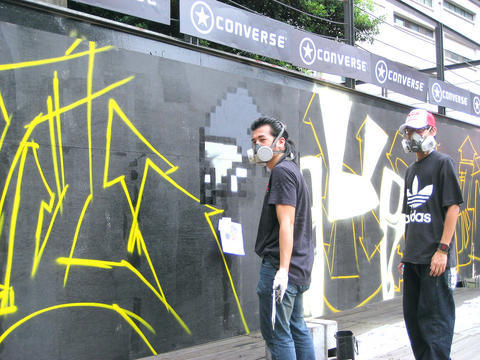For graffiti artists Ano and Bounce, there are two major challenges involved in producing graffiti in Taipei: finding the right location and avoiding detection long enough to finish the job.
A highly visible spot, such as a wall next to an MRT station, is a perfect location for street art. But in such a busy place, it is hard to spend several hours working on a piece without attracting the attention of the police.
"We like to express ourselves and communicate through graffiti, but the city punishes us for presenting our works in an unconventional location and manner," Ano, who has been a graffiti artist for six years and whose works can be found on many street corners in Taipei, told the Taipei Times.

PHOTO COURTESY OF TAIPEI CITY'S CULTURAL AFFAIRS DEPARTMENT
As a relatively young art form in Taiwan, graffiti is often dismissed as vandalism. Although the Taipei City Government softened its stance somewhat in 2005, when it made three of the retaining walls at Dachia Ying Feng Riverside available to graffiti artists, most artists still work in out-of-the-way places to avoid the police.
Things took a turn for the worse last year, when the city's Department of Environmental Protection established an around-the-clock hotline and cash rewards for those who report graffiti.
Graffiti artists face fines of between NT$1,200 and NT$6,000 for violating Article 27 of the Waste Disposal Act (
This lack of freedom frustrates Bounce and Ano, who declined to give their real names.
"We are not bad kids and we take graffiti as an art form very seriously. We don't write four-letter words or paint horrible images," Bounce said.
The duo try to avoid stereotypical "dirty," gloomy or creepy grafitti in favor of "cute" pieces with bright, warm colors and positive messages.
Bounce centers his pieces around a blind rabbit that loves music -- the character from which he takes his nickname.
Ano, meanwhile, creates graffiti mosaics.
"We do graffiti to make the city more beautiful and lively," Bounce said.
In a rare gesture of reconciliation, the city's Department of Cultural Affairs announced on Saturday that the fences around major public construction sites would be made available to graffiti artists.
"We will promote graffiti starting with the public sector, and then later in the private sector too. It's our goal to beautify the city with graffiti," department head Lee Yong-ping (
The department said it was also cooperating with the city's Water Conservancy Agency to open more of the walls at municipal riverside parks to graffiti artists, while working with the Taiwan Youth Rights and Welfare Advocacy Alliance to hold graffiti contests and festivals to promote the street art.
Bounce and Ano welcomed the news, but urged the city government to provide more locations closer to downtown and with convenient transportation.
"The spaces at riverside parks are so remote that I don't even know where those walls are," Ano said.
"People think graffiti artists like to paint on dark and abandoned walls or buildings, but the truth is we are afraid of those places. We'd love to do our art in a bright and safe environment," he said.
Having spent years sneaking around the city in search of the perfect canvas, Bounce and Ano hope that they will soon be able to share their creativity more openly.

The Ministry of Foreign Affairs (MOFA) yesterday voiced dissatisfaction with the Comprehensive and Progressive Agreement for Trans- Pacific Partnership (CPTPP), whose latest meeting, concluded earlier the same day, appeared not to address the country’s application. In a statement, MOFA said the CPTPP commission had "once again failed to fairly process Taiwan’s application," attributing the inaction to the bloc’s "succumbing to political pressure," without elaborating. Taiwan submitted its CPTPP application under the name "Separate Customs Territory of Taiwan, Penghu, Kinmen and Matsu" on Sept. 22, 2021 -- less than a week after China

THE GOOD WORD: More than 100 colleges on both sides of the Pacific will work together to bring students to Taiwan so they can learn Mandarin where it is spoken A total of 102 universities from Taiwan and the US are collaborating in a push to promote Taiwan as the first-choice place to learn Mandarin, with seven Mandarin learning centers stood up in the US to train and support teachers, the Foundation for International Cooperation in Higher Education of Taiwan (FICHET) said. At the annual convention of the American Council on the Teaching of Foreign Languages held over the weekend in New Orleans, Louisiana, a Taiwan Pavilion was jointly run by 17 representative teams from the FICHET, the Overseas Community Affairs Council, the Steering Committee for the Test of Proficiency-Huayu, the

A home-style restaurant opened by a Taiwanese woman in Quezon City in Metro Manila has been featured in the first-ever Michelin Guide honoring exceptional restaurants in the Philippines. The restaurant, Fong Wei Wu (豐味屋), was one of 74 eateries to receive a “Michelin Selected” honor in the guide, while one restaurant received two Michelin stars, eight received one star and 25 were awarded a “Bib Gourmand.” The guide, which was limited to restaurants in Metro Manila and Cebu, was published on Oct. 30. In an interview, Feng Wei Wu’s owner and chef, Linda, said that as a restaurateur in her 60s, receiving an

MORE RETALIATION: China would adopt a long-term pressure strategy to prevent other countries or future prime ministers following in Sanae Takaichi’s steps, an academic said Taiwan should maintain communications with Japan, as Japanese Prime Minister Sanae Takaichi is to lead a revision of security documents, Taiwanese academics said yesterday. Tensions have risen between Japan and China over remarks by Takaichi earlier this month that the use of force against Taiwan would constitute a “survival-threatening situation” for Japan. Prospect Foundation president Lai I-chung (賴怡忠) yesterday said Takaichi’s stance regarding Taiwan is the same as past Japanese prime ministers, but her position is clearer than that of her predecessors Fumio Kishida and Shigeru Ishiba. Although Japan views a “Taiwan contingency” as a “survival-threatening situation,” which would allow its military to